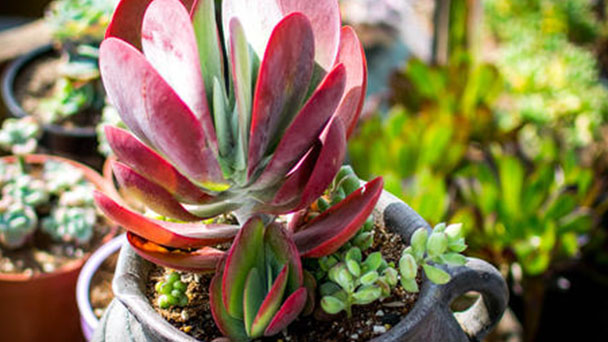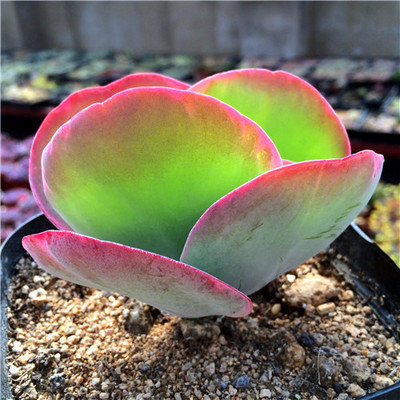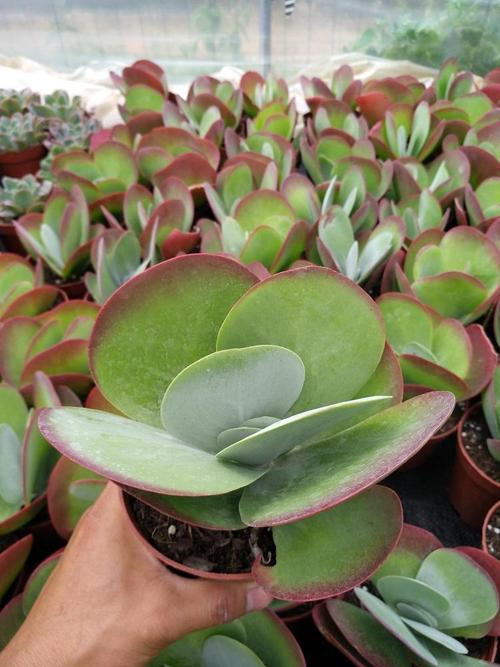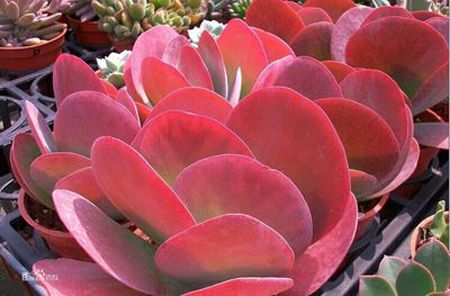Paddle Plant (Kalanchoe Thyrsifolia) Profile: Info & Care Guide
Written by Maggie
Dec 07 2021

The Paddle Plant (Kalanchoe Thyrsifolia), also called desert's cabbage is a fleshy perennial herb of the genus Paddle in the family Crocidaceae. Paddle plant is native to Cape Town and the Transvaal provinces of South Africa.
Paddle Plant Picture

Paddle Plant Morphological Characteristics
Paddle Plant (desert's cabbage) is a fleshy perennial herb with a stout, graying, branched stem and densely arranged opposite leaves. Leaf blade of paddle plant is obovate, 10 ~ 1 long, 5 cm, 5 -- 7 cm wide, entire, apex obtuse. Leaves are pale green or yellow-green in color, with a dense pinkish white, and therefore grayish-green in color. In the cool season from late autumn to early spring, the leaves are reddish in sunny conditions. The floret of Paddle Plant is tubular, yellow, 1.5 cm long.
Paddle Plant Growing Environment
The Paddle Plant (desert's cabbage) is half shade resistant, slightly cold resistant. In winter to give enough sunshine, keep basin soil moderately dry, and can withstand the low temperature of 3 ~ 5℃. The Paddle Plant grows weakly or stops growing completely when summer high temperature, and can be placed in ventilated, cool place maintenance, and temperate water, preventing rot. Spring and autumn growth boom, to see more sunshine, often watering, keep the soil moist, every 10 days or so to apply a ripe thin fertilizer. When watering and fertilizing Paddle Plant, pay attention to the fertilizer and water not to splash on the leaves, so as not to wash off the white powder on the leaf surface, affecting the viewing. Replace the pot once a year in spring, and the pot soil should be sandy loam with good drainage and air permeability.
Paddle Plant Distribution
Paddle Plant is native South Africa Cape province and the eastern Transvaal province, now the world can be cultivated in many places.

Paddle Plant Propagation
Propagation of Paddle plants (desert's cabbage) can be done in warm growing seasons by bud insertion, leaf insertion, or cuttings from stem segments with leaves. Pickle the pedicel seedlings of Paddle Plant and dry them in the shade, then plant them in the basin, or dry the leaves or cuttings for 1 to 2 days. When the wound is healed, they can be inserted into the mixture of coarse sand or nachite and vermiculite, keep the moisture and prevent rain and strong light (shading is about 40%), and take root in about 20 to 35 days. Actually seeds of Paddle Plant can be used to propagate, just time is long, the seeds for a light brown, is quite small, it can play in the shallow dish and overlying a thin layer of fine sand, also can cover on the platter of plastic or glass, to keep humidity, sprayed with a fungicide at the same time, to prevent the health seedlings by fungal diseases, about 15 ~ 30 days or so will sprout.
Stay cuttings of Paddle Plant rooting or west grew up, can colonize in the basin, can choose 4 of the coarse river sand (fine foaming refined stone or biscuit firing) plus 4 of the fine river sand, and a copy each of the organic cultivation soil, pearl stone, the mixture of vermiculite to grow, can be a first in 3.5 "in the early years of the basin, and in accordance with the growth situation to choose the larger basin, or in the open country flower bed.
Paddle Plant Care
Paddle Plant Watering
The Paddle plants (desert's cabbage) can be watered in spring and autumn to keep the soil slightly wet. Water should be properly controlled in winter and summer to keep the basin soil slightly dry. Water frequently, keep the soil moist, and apply a thin, decaying fertilizer every 10 days or so. But sometimes improper treatment will appear as a root rot phenomenon.
Paddle Plant Light Requirements
Paddle plants like light and should be cured by full light in spring and winter. In case of high temperature in summer, adequate scattered light should be ensured.
Paddle Plant Temperature Care
Paddle plants like to be cool. When the temperature is above 35℃ or below 5℃, the growth of paddle plants is slow, and the water and fertilizer should be controlled and maintained. The soil in the pot should be kept moderately dry and can withstand the low temperature of 3 ~ 5℃.
Paddle Plant Fertilizer & Pruning
Paddle plants should not be enriched with fertilizer. In spring and autumn, special fertilizer of thin and fleshy can be applied once a month. Paddle plants grow quickly and are easy to grow fruitless.

Paddle plant Uses
Ornamental Value
The leaves of the Paddle plant (desert's cabbage) are opposite, closely arranged in the shape of rose flowers, pale green in color, covered with a thick layer of white powder, and the edges of the leaves appear gradual red spots in light. The overall appearance is very attractive.
Indoor Plant
Paddle plants have large leaves, beautiful leaves and beautiful plant shape, which will be more ornamental when the Paddle Plant is in bloom or when the old Paddle Plant Stakes are growing. Paddle plants placed on several tables, balconies and other places can not only play the role of green eye protection, but also beautify the home.
Purify Air
During the day, the Paddle plants are fully photosynthesized, absorbing large amounts of harmful gases such as carbon dioxide and sulfur dioxide, and releasing fresh oxygen to freshen the indoor air.
Electric Radiation Absorption
Paddle plants also have the ability to absorb electrical radiation and formaldehyde. When raised indoors, a Paddle plant can be placed next to a TV or computer. Paddle plants can absorb small amounts of electrical radiation. In addition, the Paddle plant can also be planted indoors to absorb formaldehyde and other substances, so as to achieve the role of health protection.
Read Next: Paddle Plant (Kalanchoe Lucia) Care & Propagation Guide
Latest Updated
- Benefits of Bugleweed - 7 Science-backed Health Benefits
- Bugleweed Dangers & Side Effects - Is It Poisonous?
- How to Plant Evergreen Trees - What You Should Know
- When to Plant Evergreens - Grow Guide for Evergreen Trees
- 12 Wonderful Evergreen Shrubs for Your Garden
- 12 Popular Evergreen Plants with Pictures for Beginners
- When And How To Prune A Lilac Bush Like a Pro
- How to Grow & Care for Lilac Vine (Hardenbergia Violacea)
- Japanese Lilac Tree (Syringa Reticulata) Care & Propagation Guide
- Shumard Oak Pros and Cons - What to Know
Popular Articles
- Winter maintenance of Antirrhinum Majus
- How to Grow Terminalia Mantaly Tree
- How to Grow and Care for Crossostephium Chinense
- How to grow Antirrhinum Majus in spring
- Peristeria Elata (Dove Orchid) Profile: Info & Care Guide
- Underwatered Snake Plant (Sansevieria Trifasciata) - Signs And How To Fix
- How to Care for Brazilian Jasmine Plant (Mandevilla Sanderi)
- How to Grow & Care for Graptopetalum Purple Delight in Summer
- Rosa Chinensis (China Rose): Plant Growing & Care Tips
- How to Care for Baby Sun Rose (Aptenia Cordifolia)